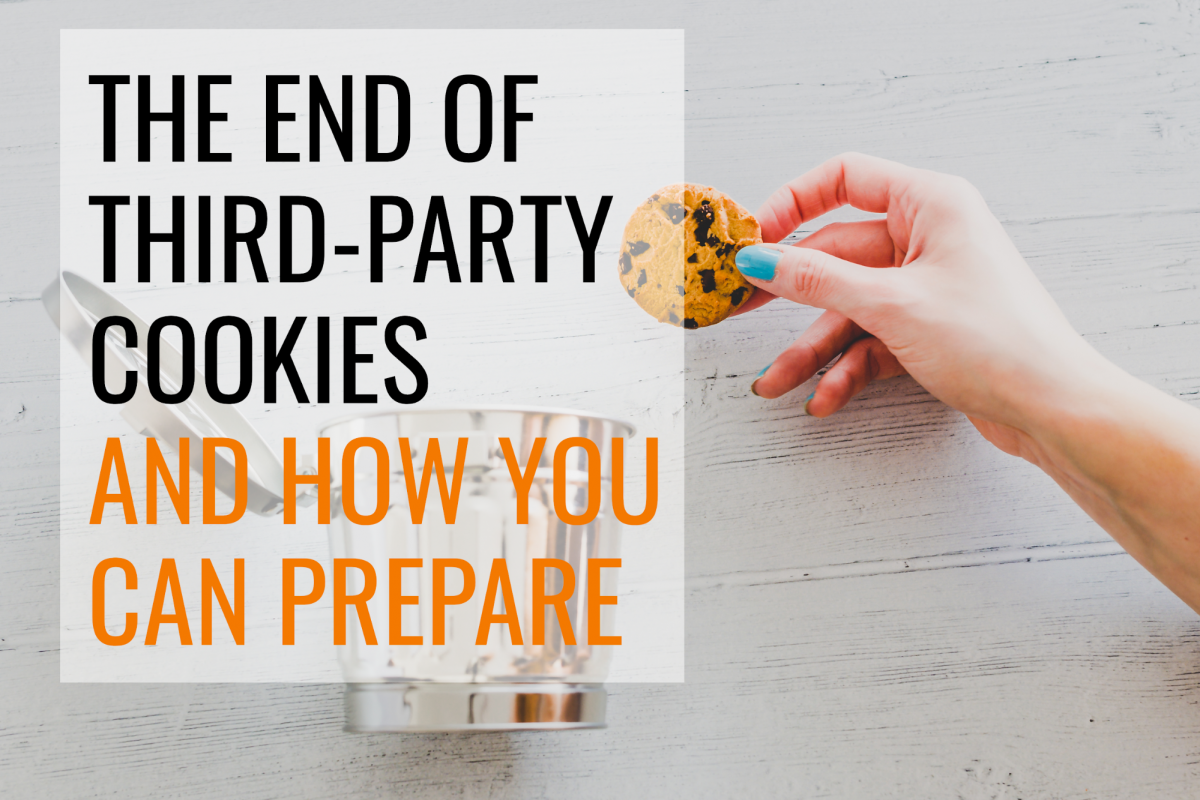When we browse the web, we want to make sure that the websites we visit will use our information in a safe and responsible way.
Internet privacy and data protection are becoming more important to people, as they become increasingly aware of just how valuable their data is, and how easily it can be exploited by others.
As a result of this increased awareness and demand for information safety, new regulations are being rolled out across the globe, with the aim of ensuring that data is not being used without consumer consent.
The big names in the web browser internet industry, namely Google Chrome, Mozilla Firefox, and Apple Safari, are adapting to comply with these new privacy legislations, which means eliminating third-party cookies from their web browsers.
But wait! What if you use third-party cookies for your e-commerce business? At first, it may sound like it spells the end of online advertising, but thankfully, it isn’t all doom and gloom.
By getting ahead of the changes now, you’ll be at the forefront of a new way of connecting with your customers in a more personalized manner. This is the time to start working on diversifying your traffic streams, and finding different ways to reach your customers. There are also a number of changes taking place right now that could allow you to use first-party data, instead of third-party to reach your customers.
In this article, I’ll highlight what this means for you and your business and show you what you can do to get ready for these big changes that are in store.
The Difference Between First-Party and Third-Party Cookies
Slightly different from the freshly baked kind, internet cookies are used to help companies distinguish one internet user from another.
There are several types of cookies, each a small text file that tracks different information or performs various tasks.
Let’s take a look at both first-party cookies and third-party cookies now.
First-party cookies help store information on user data such as login details, language preferences, and any items placed in your shopping cart. When you return to the website, all your goodies are still in the cart, and you don’t have to find and add them again. For example, think about when you visit Amazon and add a book into your cart but don’t purchase it straight away. The next time you return to Amazon (whether it’s days, or even months), your book is still there, reminding you to press “buy.” These cookies are usually associated with and stored within the website domain name itself.
First-party cookies may also help website owners with analytics and tracking the user experience to improve their websites. However, these aren’t the cookies that are being removed by web browsers and targeted by regulations. It’s the third-party ones.
Third-party cookies are from websites different from the webpage you are currently browsing and can be used by advertisers to track your web-browsing habits. For example, if a webpage you are visiting has five different advertisements, five different cookies may be generated even if you don’t click on any of the ads. Advertising suggestions are then provided based on the content you looked at.
That winter getaway to a sunny destination you briefly looked into? Well, the third-party cookie registered this, and you may start seeing advertising for hotels and trip ideas to the Dominican Republic the next time you are browsing the web. That’s because the advertisers could track your browsing history whenever you visited a webpage that had their ad on it.
How Third-Party Cookies Are Stored
Third-party cookies aren’t stored in your computer or website, as it would take up too much space. Instead, they’re being stored in external servers. This is largely what’s causing privacy concerns among the general public. Each user is assigned an identification number, and their browsing data is being collected and kept, and the ability to track users like this could potentially be exploited by others.
This already happened with the Facebook and Cambridge Analytica scandal during the 2016 presidential election. The personal data of millions of Facebook users (in one of Facebook’s largest data breaches) was used against their consent by Cambridge Analytica to create a software program that would predict and influence a voter by the time they reached the ballot box.
And this misuse of data is why the European Union (EU) introduced the General Data Protection Regulation (GDPR) and California, United States, the California Privacy Rights Act (CPRA), to help give individuals control over their private data online. And many more countries like Chile, Japan, and South Korea, are following suit.
If you have a local site or customer base that’s located outside of the EU, you may not have had to deal with GDPR. However, with third-party cookie changes coming soon, here are some starting tips for GDPR compliance and cookie compliance you can start adding to your website today.
With its elimination of third-party cookie usage in 2022, Google is following in Apple Safari and Mozilla Firefox’s steps. Both browsers block third-party cookies and have been doing so since 2017. However, Apple Safari has been the first to eliminate cookies, instead of just blocking them, since early 2020, and beating Google to it by a full two years.
According to Google, “users are demanding greater privacy – including transparency, choice and control over how their data is used – and it’s clear the web ecosystem needs to evolve to meet these increasing demands.”
But what does this demand for greater privacy mean for e-commerce businesses and advertising?
How Can E-Commerce Stores Prepare and Get Ahead?
If your business relies on third-party cookies, now is the time to re-evaluate your advertising strategy for when third-party cookies are no longer allowed in web browsers. You can start creating a new experience for your customers when it comes to their privacy and data.
First-Party Data Tools
First up, it’s time to start transitioning to the use of first-party data.
Not only will first-party data help to keep you in compliance, but this data is tremendously valuable as well. It tends to be more accurate, and it’s free as well, customers give it to you directly. Plus, of course, you own this data. No need to worry about changes to regulatory changes or platforms making changes down the road.
According to a recent Econsultancy report, “The Promise of First-Party Data,” some 74% of marketers surveyed said that they believe first-party data provides the strongest customers insights.
If you already have first-party data on your customers, there are already a few tools out there that can help you to put that data to use. There may be more options arriving on the scene soon, but for now, here are some good options that are worth exploring:
-
-
-
- LiveIntent
- Epsilon
- Oracle’s OnRamp
- LiveRamp’s Identity Link
-
-
For tips on COLLECTING that valuable first-party data, download your FREE worksheet today!
Get our The End of Third-Party Cookies - What Does It Mean for E-Commerce Businesses and How Can You Prepare_ - Worksheet delivered right to your inbox.
Trust-Building Tools for a Cookie-Free Browser Experience
For any business today, building trust with your visitors is another important part of the equation. Here’s a look at some tools that can help you to build trust with your customers:
Cookiebot (Cookie Consent)
Cookiebot is a script you can add to your website to create a cookie consent banner. It will block cookies until visitors check them and give their consent. It can also be used to detect the type of cookies and trackers on your website and data that your website collects and shares with third-party advertisers.
Grow.me
Here’s another tool, and data collection strategy, that may be worth exploring.
Grow.me is a first-party data solution from ad management company Mediavine. Even though it’s still in the beta stages, it could prove to be a useful way to expand your first-party data.
Here’s how it works. Designed as an audience engagement framework, Grow.me allows users to save content from all over the web. Essentially, it’s a personalized browsing experience for users who have opted-in and subscribed.
It also functions as a plugin that you can add to your website to turn your website into a type of social media network, giving users the ability to like your content. With the reliance on first-party cookies to collect data and pass it on to advertisers, this will help you get a head-start as the Grow.me community starts, well, growing. Learn more here.
Google’s Privacy Sandbox (A Browser Solution)
When Google announced removing third-party cookies from its browser, the company proposed its Privacy Sandbox as an alternative. Privacy Sandbox is meant to reduce the misuse of user tracking while still allowing ad advertising to take place with the Google Chrome browser.
In theory, it could work if the user presumably uses Google Chrome across all their devices. So even if the user looks at a product on their phone and then goes onto their laptop to make the purchase, advertisers can still link back to the user if they purchased a product via one of their advertisements.
It’ll be interesting to see what new tools and solutions continue to arrive on the scene as this situation develops.
Finding New Ways to Reach Your Audience
The issue of data collection aside, it also doesn’t hurt to start building alternative ways to reach your audience now. The sooner you can start, the better.
Leverage Audiences From Blogs, Social Media Pages, and Forums
Start by leveraging audiences from other sites. This includes blogs, social media pages, forums (like Reddit), and even the question and answer platform Quora. You could even target your niche through your competitor’s social media platforms and direct them towards your own content.
One excellent method for this is Facebook Groups. You can set up a group for something related to your niche and what you’re selling. I used this approach with RTA Cabinets, and it was a great way to grow our audience. I started by setting up groups for cooking, BBQing, and other things that our target audience was interested in. I then had a platform that I could use to reach out to them directly. I would share content related to those niches, and occasionally drop in a post from RTA cabinets. Since the posts were helpful and non-promotional, this was a great way to grow my following and market my company at the same time.
Consider Contextual Advertising
While we look towards strategies that can pinpoint online audiences without third-party cookies, maybe we should be looking back at older ones that worked well too, like contextual advertising.
“While third-party data allowed you to place ads directly in front of people who matched certain user profiles, contextual advertising allows you to circulate PPC [pay-per-click] ads on websites that rank for similar keywords as your ad,” states Hubspot. “This way, if you’re selling sports apparel, your PPC ad could show up on sports-oriented websites.”
The end of third-party cookies means that your focus needs to be on building relationships with your target audience. It’s also highlighted the importance of owning your own customer data, building your own email lists, and looking to establish multiple traffic sources.
It’s vitally important to own your own first-party customer data. If you don’t have a funnel that you’re currently using to collect email addresses, that’s another great place to start.
Today it might be third-party cookies, tomorrow it may be something else. It’s always best to stay ahead of the curve, and try to continually develop newer and more refined marketing strategies to reach your customer base. In the meantime, try to focus on growing your first-party data; you never know when you might need to use it!
Ready to start collecting first-party data? Download your FREE worksheet for tips on gathering first-party data.
Get our The End of Third-Party Cookies - What Does It Mean for E-Commerce Businesses and How Can You Prepare_ - Worksheet delivered right to your inbox.







